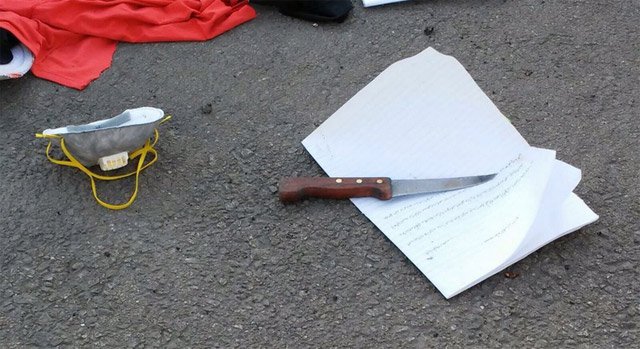Kitchen knives. Meat cleavers. Scissors. Stones. The current weapons of choice used by Palestinians in this latest wave of violence in Israel and the West Bank. At the time of writing, 22 Israelis, 150 Palestinians, an American and an Eritrean have been killed. In the past three months, there have been 105 stabbings - and many of the perpetrators have been women. With murmurings that this wave of violence constitutes a new uprising - a third intifada - I believe that if this is indeed a third intifada, it is very different than the two previous ones: it is less orchestrated - and more intimate. An Intimate Intifada.
As of now, sixteen of the assailants in this “intimate” intifada have been women. Seven of these women were seen stabbing Jewish men in public spaces, seven of them were apprehended before the attempted stabbing, one of them attempted a car ramming and one of them had an explosive device in her car that detonated early. The disturbing novelty of this intifada is not that women are capable of engaging in violence - women have willingly and passionately committed acts of terrorism for centuries, as has been thoroughly researched by terrorism scholars Mia Bloom and Yoram Schweitzer - but the novelty here is the intimacy of these attacks.
It is intimate because the weapon of choice, knives, requires a physical closeness between the attacker and the victim. Unlike in suicide terror or bomb attacks, there is no physical distance that shields the killer from the eyes of the doomed. It is intimate because its agents are not jihadi foot soldiers but instead self-motivated individuals, acting on their own agency.
These sixteen women assailants embody two main traits: they are young; twelve of the sixteen are under the age of 23, the youngest being 14; and they are self-motivated, acting as ‘lone-wolves.’ These woman were born into the post Oslo Accords era. Born into a time with the continued presence of the occupation and little to no meaningful dialogue or resolution between Israel and Palestine on the table. While I do not condone this violence, the hopelessness and desperation felt by the assailants are important dimensions to it.
Why are such numbers of Palestinian women suddenly up arms?
The first intifada, 1987-1993, did not have a call to action among women. Instead, as Mira Tzoreff argues, women were tasked with being the “birthers” of the revolution, the cultivators, the mothers of the sons who would carry out the attacks. The second intifada, 2000-2005, brought about the first female Palestinian suicide bomber, Wafa Idris. It brought about direct female engagement in the violent acts, in the terror. As suggested by Yoram Schweitzer, these women were mostly in their 20s, unmarried or divorced, and childless. It is believed that these women were looking for some way to absolve the shame and/or dishonor they brought upon themselves and their families. Martyrdom proved to be a way to combat their dishonor or shame.
What makes the women tick?
I believe that one of the reasons we are seeing an escalation of women’s involvement in this intifada is because the nature of the attacks require little to no planning. A stabbing with a kitchen knife is something an individual can plan without needing the infrastructure of a terrorist organization. Yet I also believe the nature of the attacks is directly related to the desperation many Palestinians, especially women, who bear the main burden, are feeling and the idea that desperate times call for desperate measures. Women are acting because they are desperate to change their situation; women act because they believe that their male counterparts are not doing enough in the fight against the occupation.
As most assailants were killed on site, little is known about what truly led them to engage in this intimate form of violence, what led them to pick up their knives. From the little we know we can only put together an incomplete mosaic of different motivations.
We only really understand two backstories. The first is of Isra’ ‘Abed who committed the Afula attack on October 9th. She was apprehended for what was perceived to be brandishing a knife at a local bus station. However, law enforcement soon concluded that she, in fact, wanted to be caught and induce the police to shoot her. Murder by suicide. She is a divorced mother who suffers from mental illness, has a history of hospitalizations and lost custody of her child after attempting suicide. She posed as a terrorist, hoping and possibly knowing, what reaction it would cause.
'Awakening,' by Akrem Boutora, has been widely shared by Palestinian activists. Photo: Haaretz
On the opposite end of the spectrum, Rasha Ahmad Hamed ‘Oweissi perpetrated the attempted stabbing in Qalqilia on November 9th. Rasha was shot and killed after attempting a stabbing at a checkpoint and left behind a suicide note. In this note, she highlights her motivations for the attack: “My dear mother, I don’t know what is happening. I just know that I’ve reached the end of the road. And this is the road that I chose with full consciousness. In defense of my homeland, the young men and women, I cannot bear what I see anymore. But what I know is that I can’t take it anymore…Forgive me for everything, I have nothing else but this path. I am sorry for this departure.”

Knife and suicide note found on Rasha Ahmad Hamed ‘Oweissi in attempted stabbing 9 November 2015. Photo: Israel Ministry of Defense
While these two women represent attempted stabbings and there is an understanding of why they wanted to engage or be perceived as engaging in this violence, it is important to remember that there are assailants who use being a woman to their advantage. The November 8th attack in Beitar Illit (south of Jerusalem) caught Halawa Alian on camera engaging in several minutes of conversation with an Israeli security guard before ultimately reaching into her purse, pulling out a knife and stabbing him.
And Still...
In October, Hamas released a graphic 45-second video tutorial instructing Palestinians how to stab a Jew. In this video, actors portrayed two religious Jews cornered by a Palestinian man and stabbed to death. As disturbing as the video was, it is important to note that women played no role in it. Despite that notable absence, other assailants, such as Muhannad Halabi (stabbing attack on October 3) and Ishaq Badran (stabbing attack on October 10) specifically mentioned the need to protect their Muslim sisters as a motive for their actions. Ergo, there is a nuance.
Mia Bloom and Yoram Schweitzer argue that only when times get extremely desperate do women get actively involved in terror. So, are Palestinians at a breaking point? Bombs and IEDs are no longer the weapons of choice, instead, going to the streets and stabbing with knives is the new course of action. I believe that such actions highlight an entirely new level of anger and desperation among Palestinians. Recognizing and understanding Palestinian women’s unprecedented engagement in this violence is a small but important step in ending this new intifada.
Read more
Get our weekly email





Comments
We encourage anyone to comment, please consult the oD commenting guidelines if you have any questions.